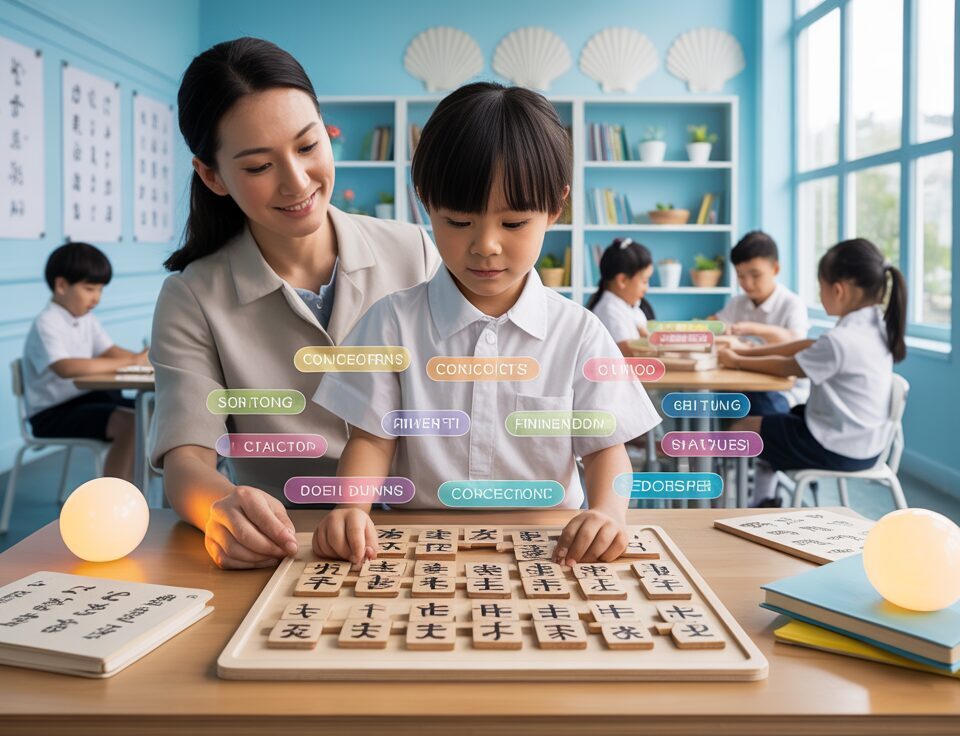
Mastering Chinese Vocabulary: The Spaced Repetition Method for Primary School Success
November 6, 2025
Chinese Cloze Passage Traps: Expert Guide to Spot and Solve Challenging Questions
November 9, 2025Table Of Contents
- Introduction to Food & Dining Vocabulary in Chinese
- Basic Food Terms Every Primary Student Should Know
- Essential Dining Phrases and Expressions
- Chinese Food Categories and Classifications
- Common Cooking Methods in Chinese
- Restaurant and Ordering Vocabulary
- Cultural Context: Food in Chinese Society
- Practical Applications for Primary Students
- Fun Learning Activities to Master Food Vocabulary
- Conclusion: Bringing Chinese Food Vocabulary to Life
Food is not just sustenance—it’s a central part of Chinese culture and daily life. For primary school students learning Chinese, mastering food and dining vocabulary opens a delicious doorway to cultural understanding and practical language skills. Whether ordering at a restaurant, discussing favorite meals, or understanding recipe instructions, food-related vocabulary forms an essential foundation in Chinese language learning.
At Seashell Academy by Suntown Education Centre, we recognize that learning thematic vocabulary like food terms should be engaging, relevant, and connected to real-world experiences. Rather than memorizing isolated words, our approach encourages students to understand vocabulary in context—just as ingredients come together to create a delightful dish!
This comprehensive guide presents essential Chinese food and dining vocabulary tailored specifically for primary students. From basic food names to restaurant phrases, cooking methods to cultural insights, we’ve organized this vocabulary guide to support progressive learning and practical application—aligning perfectly with our Seashell Method that balances academic excellence with enjoyable learning experiences.
Essential Chinese Food & Dining Vocabulary
A visual guide for primary students
1Staple Foods (主食)
- 米饭 (mǐ fàn) – rice
- 面条 (miàn tiáo) – noodles
- 馒头 (mán tou) – steamed bun
- 饺子 (jiǎo zi) – dumplings
- 包子 (bāo zi) – steamed stuffed bun
2Table Phrases (餐桌用语)
- 我饿了 (wǒ è le) – I’m hungry
- 请用餐 (qǐng yòng cān) – Please eat
- 好吃吗? (hǎo chī ma) – Is it delicious?
- 我吃饱了 (wǒ chī bǎo le) – I’m full
- 干杯 (gān bēi) – Cheers
The Five Flavors (五味)
tián
sweet
suān
sour
kǔ
bitter
là
spicy
xián
salty
3Cooking Methods (烹饪方法)
4Restaurant Phrases (餐厅用语)
- 我要点菜 (wǒ yào diǎn cài)
I want to order - 菜单在哪里? (cài dān zài nǎ lǐ)
Where is the menu? - 有什么推荐? (yǒu shén me tuī jiàn)
What do you recommend? - 买单 (mǎi dān)
Check, please
Festive Foods (节日食品)
春节 (Spring Festival)
饺子 (jiǎo zi)
Dumplings symbolizing wealth
中秋节 (Mid-Autumn)
月饼 (yuè bing)
Mooncakes for family unity
端午节 (Dragon Boat)
粽子 (zòng zi)
Rice dumplings to honor Qu Yuan
Practical Applications
Examination Success
Food vocabulary frequently appears in compositions and reading comprehension passages
Restaurant Interactions
Order food confidently at Chinese restaurants using authentic vocabulary
Cultural Understanding
Appreciate Chinese cultural traditions through food-related vocabulary
Basic Food Terms Every Primary Student Should Know
Building a strong foundation in Chinese food vocabulary starts with mastering the essentials. These fundamental terms appear frequently in textbooks, examinations, and everyday conversations. Let’s explore the basic food vocabulary that every primary student should confidently recognize and use:
Staple Foods (主食 – zhǔ shí)
Staple foods form the foundation of Chinese cuisine and are essential vocabulary for primary students:
米饭 (mǐ fàn) – rice
面条 (miàn tiáo) – noodles
馒头 (mán tou) – steamed bun
饺子 (jiǎo zi) – dumplings
包子 (bāo zi) – steamed stuffed bun
These staple foods appear frequently in Chinese compositions and oral examinations. For example, a Primary 4 student might need to describe their favorite meal in a composition: “我最喜欢吃妈妈做的米饭和炒菜” (I love eating rice and stir-fried vegetables made by my mother).
Fruits and Vegetables (水果和蔬菜 – shuǐ guǒ hé shū cài)
Fruits and vegetables feature prominently in health-related topics, making them important vocabulary for primary students:
苹果 (píng guǒ) – apple
香蕉 (xiāng jiāo) – banana
橙子 (chéng zi) – orange
西瓜 (xī guā) – watermelon
草莓 (cǎo méi) – strawberry
白菜 (bái cài) – Chinese cabbage
青菜 (qīng cài) – green vegetables
西红柿 (xī hóng shì) – tomato
土豆 (tǔ dòu) – potato
胡萝卜 (hú luó bo) – carrot
At Seashell Academy, we teach students to use these terms in context through creative activities. For instance, in our P4 Chinese Programme, students might create a menu using these vocabulary words, reinforcing both writing skills and vocabulary retention.
Essential Dining Phrases and Expressions
Beyond individual food items, mastering common phrases used during meals helps students navigate real-life dining situations and demonstrates cultural fluency. Here are key expressions every primary student should know:
Before and During a Meal
我饿了 (wǒ è le) – I’m hungry
我渴了 (wǒ kě le) – I’m thirsty
开饭了 (kāi fàn le) – The meal is ready/It’s time to eat
请用餐 (qǐng yòng cān) – Please eat (formal invitation to start eating)
我开动了 (wǒ kāi dòng le) – I’ll start eating (polite expression before eating)
慢慢吃 (màn man chī) – Take your time eating/Eat slowly
好吃吗?(hǎo chī ma) – Is it delicious?
很好吃!(hěn hǎo chī) – Very delicious!
Table Manners and Requests
请给我… (qǐng gěi wǒ…) – Please give me…
再来一点… (zài lái yī diǎn…) – A little more…
我吃饱了 (wǒ chī bǎo le) – I’m full
谢谢您的款待 (xiè xiè nín de kuǎn dài) – Thank you for your hospitality
干杯 (gān bēi) – Cheers (when drinking)
In our P5 Chinese Programme, students practice these phrases through role-play exercises that simulate real restaurant and home dining scenarios, making the vocabulary immediately applicable to their daily lives.
Chinese Food Categories and Classifications
Understanding how food is categorized in Chinese culture helps students organize their vocabulary knowledge and provides cultural insights. These classifications appear frequently in reading comprehension passages in primary school examinations.
The Five Flavors (五味 – wǔ wèi)
Chinese cuisine traditionally recognizes five basic flavors, which are important descriptive terms for primary students to master:
甜 (tián) – sweet
酸 (suān) – sour
苦 (kǔ) – bitter
辣 (là) – spicy
咸 (xián) – salty
These flavor terms help students describe food preferences and are essential for composition writing. For example, “我喜欢吃甜的食物,但是不喜欢吃辣的。” (I like to eat sweet foods, but I don’t like spicy ones.)
Meal Classifications
Understanding meal structure helps students organize their vocabulary and comprehend reading passages:
早餐 (zǎo cān) – breakfast
午餐 (wǔ cān) – lunch
晚餐 (wǎn cān) – dinner
点心 (diǎn xin) – dim sum/snacks
小吃 (xiǎo chī) – small eats/snacks
宵夜 (xiāo yè) – late night snack
Regional Cuisines (中国八大菜系 – zhōng guó bā dà cài xì)
For advanced Primary 5-6 students, introducing the concept of China’s eight major culinary traditions provides valuable cultural knowledge:
川菜 (chuān cài) – Sichuan cuisine (known for spiciness)
粤菜 (yuè cài) – Cantonese cuisine (known for freshness)
闽菜 (mǐn cài) – Fujian cuisine (known for seafood)
苏菜 (sū cài) – Jiangsu cuisine (known for artistic presentation)
浙菜 (zhè cài) – Zhejiang cuisine (known for freshness and tenderness)
At Seashell Academy, our P6 Chinese Programme incorporates these advanced cultural concepts into composition writing and oral discussions, preparing students for both PSLE success and deeper cultural understanding.
Common Cooking Methods in Chinese
Understanding cooking terminology enhances reading comprehension and expands students’ descriptive vocabulary. Chinese cuisine is renowned for its diverse cooking techniques, each creating distinct flavors and textures.
Basic Cooking Verbs
炒 (chǎo) – to stir-fry
煮 (zhǔ) – to boil
蒸 (zhēng) – to steam
炸 (zhá) – to deep-fry
烤 (kǎo) – to roast/bake
煎 (jiān) – to pan-fry/sauté
炖 (dùn) – to stew
烩 (huì) – to braise
These cooking verbs often appear in procedural texts and recipes that students encounter in reading comprehension exercises. For example, “我们先把鸡蛋煎熟,然后再把青菜炒一炒。” (First, we pan-fry the eggs until cooked, then stir-fry the vegetables briefly.)
In our interactive lessons at Seashell Academy, we often use picture cards and simple cooking demonstrations to help students visualize and remember these cooking methods, making abstract vocabulary concrete and memorable.
Restaurant and Ordering Vocabulary
For primary students, knowing how to navigate restaurant situations in Chinese provides practical language application opportunities and builds confidence in real-world settings.
Restaurant Personnel
服务员 (fú wù yuán) – waiter/waitress
经理 (jīng lǐ) – manager
厨师 (chú shī) – chef
收银员 (shōu yín yuán) – cashier
Useful Phrases for Ordering
我要点菜 (wǒ yào diǎn cài) – I want to order
菜单在哪里?(cài dān zài nǎ lǐ) – Where is the menu?
这个多少钱?(zhè ge duō shǎo qián) – How much is this?
有什么推荐?(yǒu shén me tuī jiàn) – What do you recommend?
我想要一份… (wǒ xiǎng yào yī fèn…) – I would like one serving of…
买单 (mǎi dān) – Check, please
These practical phrases align perfectly with Seashell Academy’s focus on real-life application of knowledge. In our Chinese programmes, we create simulated restaurant scenarios where students practice ordering in Chinese, preparing them for authentic communication experiences.
Cultural Context: Food in Chinese Society
Understanding the cultural significance of food in Chinese society provides valuable context that enhances vocabulary retention and cultural appreciation for primary students.
Festive Foods and Their Meanings
Chinese festivals are often celebrated with specific foods that carry symbolic meanings:
饺子 (jiǎo zi) – dumplings (Chinese New Year – represent wealth)
汤圆 (tāng yuán) – glutinous rice balls (Lantern Festival – represent family reunion)
月饼 (yuè bing) – mooncakes (Mid-Autumn Festival – represent family unity)
粽子 (zòng zi) – rice dumplings (Dragon Boat Festival – commemorate Qu Yuan)
Understanding these associations helps students connect vocabulary to cultural knowledge, creating multiple memory pathways that enhance retention. At Seashell Academy, we integrate cultural discussions into our vocabulary lessons, helping students understand not just the words but the rich cultural tapestry behind them.
Food-Related Idioms (成语 – chéng yǔ)
For advanced primary students, simple food-related idioms enhance both vocabulary and cultural understanding:
津津有味 (jīn jīn yǒu wèi) – to enjoy something thoroughly (literally: with relish)
食之无味 (shí zhī wú wèi) – tasteless/unappetizing (used to describe something uninteresting)
余味无穷 (yú wèi wú qióng) – aftertaste that lingers on (used to describe lasting impressions)
Through our Programme Philosophy that emphasizes holistic learning, we help students see how these idioms connect language to culture and everyday experiences, making learning more meaningful and memorable.
Practical Applications for Primary Students
At Seashell Academy by Suntown Education Centre, we believe that vocabulary learning should be immediately applicable to real-life situations. Here are practical scenarios where primary students can apply their Chinese food vocabulary:
Examination Applications
Food vocabulary frequently appears in PSLE Chinese examinations in various forms:
– Composition topics about family meals, restaurant experiences, or cooking
– Picture composition scenarios featuring food-related activities
– Reading comprehension passages describing meals or food preparation
– Oral examination questions about food preferences or experiences
Students who master food vocabulary have a significant advantage in these examination scenarios, as they can express themselves more precisely and understand passages more thoroughly.
Real-Life Scenarios
Beyond examinations, food vocabulary empowers students in everyday situations:
– Ordering food at Chinese restaurants
– Reading menus and food labels
– Following simple recipes in Chinese
– Discussing food preferences with Chinese-speaking relatives
– Understanding food-related cultural references in Chinese media
These practical applications make vocabulary learning meaningful and motivating for students, aligning with our Seashell Method that emphasizes the real-world relevance of language learning.
Fun Learning Activities to Master Food Vocabulary
At Seashell Academy, we transform vocabulary learning from rote memorization into engaging, interactive experiences. Here are some of the activities we use to help primary students master food vocabulary while enjoying the learning process:
Mind-Mapping Food Categories
Creating visual mind maps helps students organize vocabulary in meaningful ways. Students can create mind maps of food categories (fruits, vegetables, meats), cooking methods, or flavors. This visual approach aligns with our Seashell Method’s emphasis on structured learning and visual organization of knowledge.
Role-Play Restaurant Scenarios
Students take turns playing customers and restaurant staff, practicing ordering dialogues and using restaurant vocabulary in context. This interactive approach builds confidence in real-world language application and makes vocabulary immediately useful.
Food Description Games
Students practice describing foods without naming them, using vocabulary for appearance, taste, texture, and cooking methods. Other students guess the food being described. This game enhances descriptive language skills while reinforcing multiple vocabulary categories.
Through these engaging activities, students at Seashell Academy develop a genuine enthusiasm for Chinese language learning, consistent with our belief that effective learning happens when students are emotionally engaged and enjoying the process.
Conclusion: Bringing Chinese Food Vocabulary to Life
Mastering food and dining vocabulary is an essential component of primary Chinese language learning, offering students both academic advantages and practical life skills. At Seashell Academy by Suntown Education Centre, we approach this vocabulary domain not as isolated words to memorize, but as a living language connected to cultural understanding, daily experiences, and meaningful communication.
Through our structured yet engaging Seashell Method, we help students build food vocabulary knowledge systematically—from basic food names to cultural associations, from simple descriptions to nuanced expressions. This comprehensive approach ensures that students not only perform well in examinations but also develop confidence in real-world Chinese language use.
Food vocabulary offers a perfect blend of practical utility and cultural richness, making it an ideal thematic vocabulary area for demonstrating our core philosophy: that effective learning combines academic excellence with emotional well-being, structured approaches with joyful discovery, and examination preparation with life-long language appreciation.
By mastering the vocabulary presented in this guide, primary students gain more than words—they gain access to a fundamental aspect of Chinese culture and daily life, building a foundation for both PSLE success and meaningful cultural connection.
Nurture Your Child’s Chinese Language Journey at Seashell Academy
Looking to help your child master Chinese vocabulary and develop genuine confidence in Chinese language skills? Seashell Academy by Suntown Education Centre offers specialized Chinese programmes for Primary 1-6 students, featuring our unique Seashell Method that makes learning engaging, meaningful, and effective.
Our experienced MOE-trained educators provide personalized attention in small classes, ensuring your child receives the guidance they need to excel in both examinations and real-world language use.
Contact us today to learn more about our Chinese language programmes or to schedule a consultation with our educational experts.





